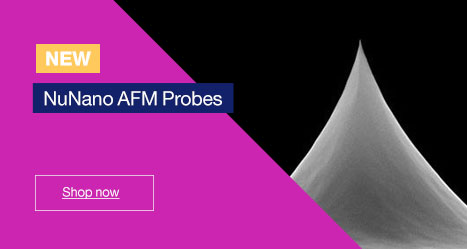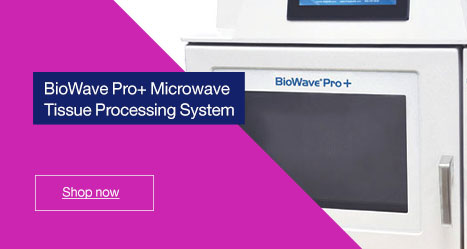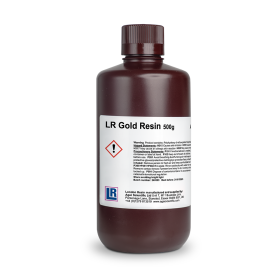LR GOLD PROCESSING AND POLYMERISATION

Striated muscle longitudinal section. Stained with Toluidine Blue.
2 µm section
TISSUE
Tissue samples up to 5 x 5 x 5 mm have been successfully processed using the following schedule. However, it is recommended that tissue specimens of maximum 3 x 3 x 3 mm are used and as a general rule the smaller the specimen the more efficient the impregnation. The thickness of the tissue is particularly important when polymerising darkly coloured tissue such as liver and spleen, because complete polymerisation depends on the blue light from the light source being able to penetrate the full thickness of the tissue. Tissue used is fresh and unfixed.
PROCESSING
Processing is performed in 1 ml vials with tight-fitting lids on a rotary agitator. The fluids involved are maintained in bulk at the sub-zero temperatures required. Also, the final resins, it must be remembered, are sensitive to prolonged light exposure and are therefore stored in the dark and handled as infrequently as possible. We recommend the use of polyvinyl pyrollidone to protect unfixed tissue from osmotic changes during processing. We have used PVP with an approximate molecular weight of 44,000. This can be dissolved in methanol, water and the London Resin Gold monomer. Concentrations of 50% w/v are possible in the methanol mixtures, however, at low temperatures the resulting viscosity is impractical. The following schedule shows the PVP concentrations recommended, the resulting LM work being very satisfactory. It must be said, however, that the addition of PVP in different concentrations may further improve morphology, especially in the EM.
FRESH TISSUE
50% methanol + 20% PVP | 0°c | 15 min |
70% methanol + 20% PVP | -25°c | 45 min |
90% methanol + 20% PVP | -25°c | 45 min |
50% LR Gold monomer/50% methanol + 10% PVP | -25°c | 30 min |
70% LR Gold monomer/30% methanol + 10% PVP | -25°c | 60 min |
100% LR Gold monomer | -25°c | 60 min |
100% LR Gold monomer + initiator | -25°c | 60 min |
100% LR Gold monomer + initiator | -25°c | Overnight |
100% LR Gold monomer + initiator | -25°c | 20-25 hours |
POLYMERISATION
The addition of a light-sensitive initiator is needed in order to polymerise the resin and we recommend BENZIL, an alphadiketone, at a concentration of 0.1% w/v. The principle is shown in the diagram. The gelatin capsules are 00 size and the plastic support is a modified haemagglutination tray. The bulb involved here is a Thorn projector lamp (Al /209 FDX, 12V IO0W). We have found that 7 to 9 V will cause solidification within 24 hours. Like many acrylic resins, oxygen will inhibit polymerisation, therefore the capsules are filled completely and lids fitted. Paper labels can be inserted into the capsules. 9 capsules (3 x 3) may be polymerised at any one time.
If the upper surface is still soft after 24 hours this can be trimmed off or hardened in daylight for a few hours prior to peeling off the gelatin. The blocks once polymerised need not be stored cold, however, it may prolong the activity of some enzymes to do so.
The enzyme histochemistry performed to date using the resin has involved conventional reagents, times of reaction and temperatures (see Thompson and Germain, Histochemical Journal Vol. 15, No. 12, December 1983.)
For room temperature polymerisation, using a peroxide/amine cure, add to pure LR Gold either 1% of dry benzoyl peroxide or, more safely, 1.5% of benzoyl peroxide paste (60% in dibutyl phthalate). Infiltrate with pure LR Gold solution adding only the peroxide mix prior to polymerisation. To reduce curing exotherm, cool mould in ice water. To accelerate cure, add 1 drop of LR White accelerator to 20ml LR Gold resin/benzoyl peroxide mixture. To U.V light cure LR Gold, add benzoin methyl ether. The precise concentration will depend on the power and emission spectrum of your UV lamp.
However, a useful starting concentration would be 0.5%.
The cross-link density of the final resin is important. If stains are not penetrating sufficiently quickly, reduce the benzil concentration rather than the light intensity or exposure time.
SECTIONING AND MOUNTING
The LR Gold blocks, following polymerisation, can be stored, handled and cut at room temperature. Cutting should preferably be done using a motorised microtome and glass knife. Sections may be cut dry, picked up and placed free-floating into incubating medium or buffer wash for enzyme histochemistry or immunocytochemistry.
It is not advisable to mount sections onto slides before reacting since this involves heat and would be deleterious to the unfixed proteins. The section can of course be mounted in the usual way after enzyme histochemistry or immunocytochemistry has been carried out.

Photo: Cryoloymerization Unit



